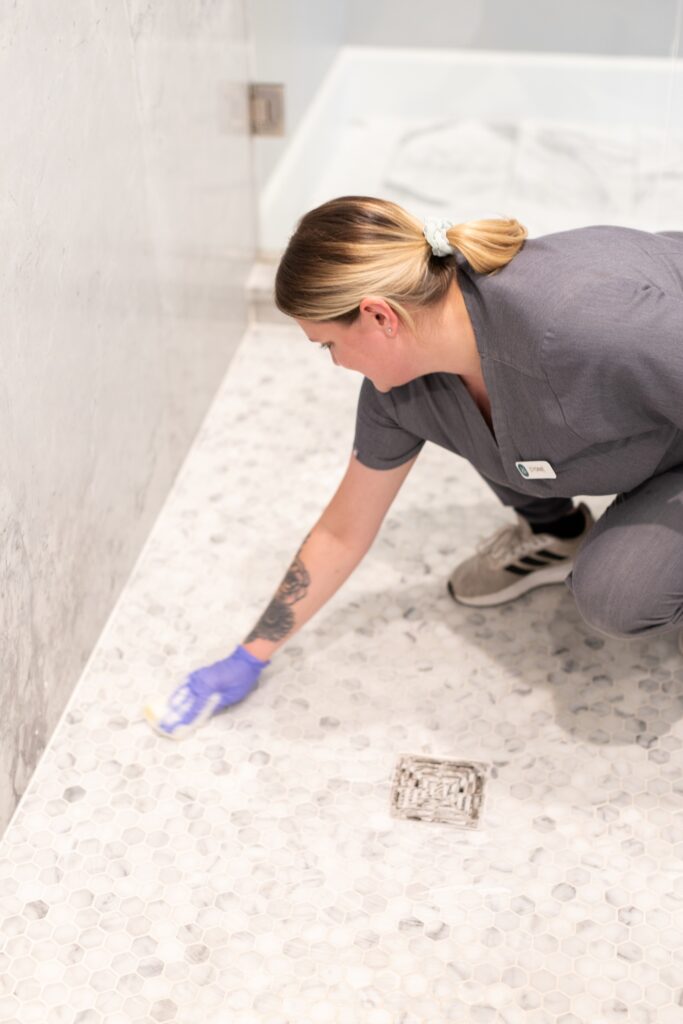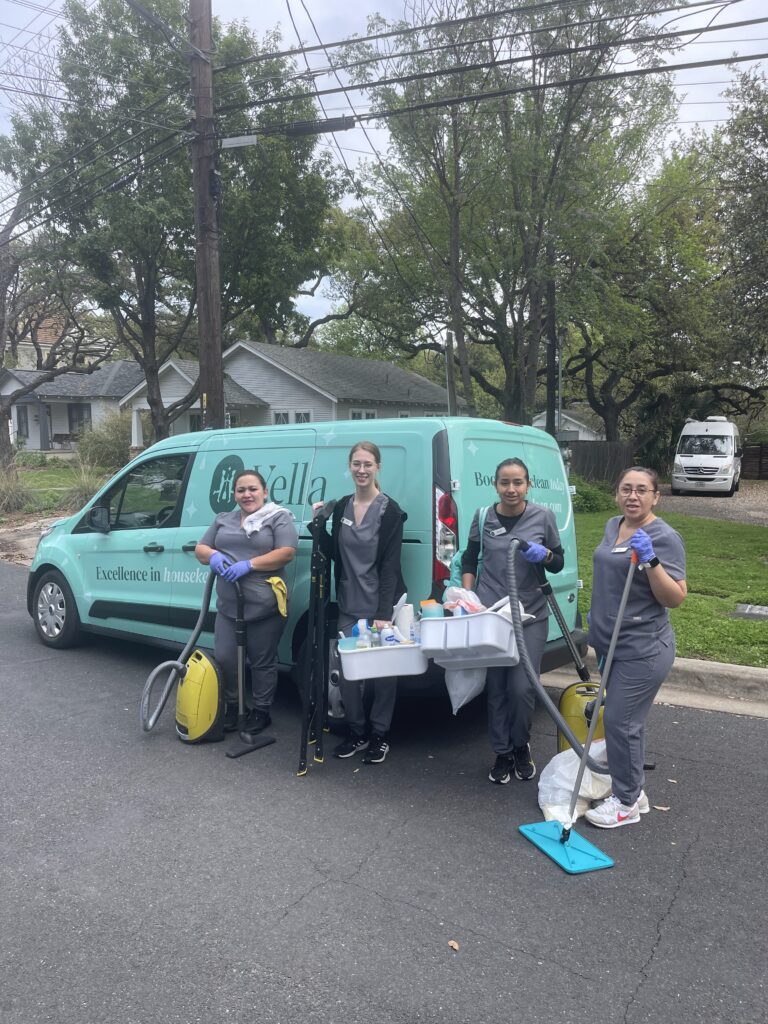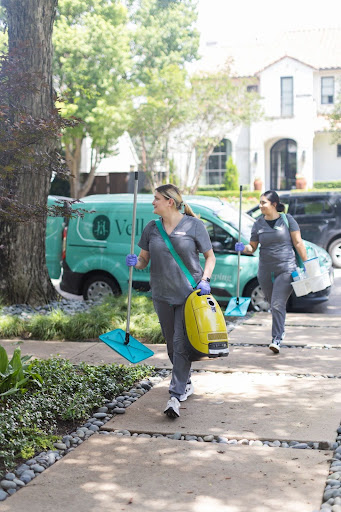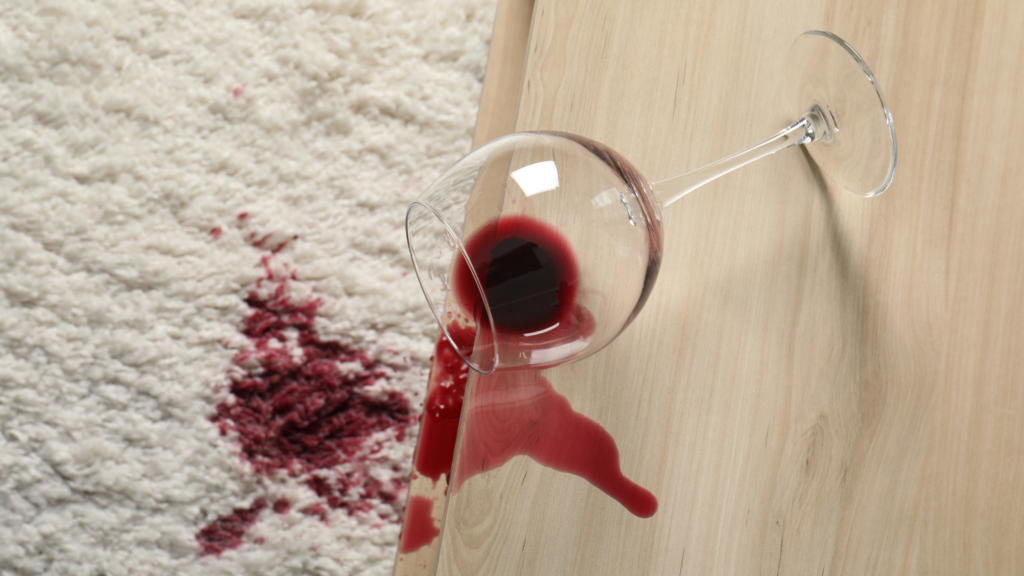Eco-Friendly Grout & Tile Cleaning Guide for Fort Worth Homes

Living in Fort Worth means dealing with more than just everyday messes. Between hard water, dusty Texas winds, and constant foot traffic, it doesn’t take long for your tile and grout to look worn down. You might notice grout lines turning dark, tiles losing their shine, and stubborn buildup that just won’t budge.
At Vella, we know the impact Fort Worth’s unique conditions can have on your home’s surfaces. That’s why we created this guide: to help you clean smarter, not harsher. From safe, at-home remedies using common ingredients to pro-level tools and eco-certified products, this blog breaks down exactly how to clean and protect your grout and tile, without compromising your health or the planet.
Why Regular Grout Cleaning Matters
Keeping up with grout cleaning in Fort Worth is not just about looks. Here’s why staying on top of grout care matters in Fort Worth homes:
When not cleaned regularly, grout can trap mildew and mold that worsen indoor air quality and trigger allergies. And with Fort Worth’s hard water, grout can be affected by minerals that can lead to yellowing and deteriorate the tile over time. Regular cleaning keeps the grout fresh while maintaining the tile surface and increasing the life of the entire floor.
Eco-Friendly Grout Cleaning Tips for Fort Worth Homes
Keeping the grout clean doesn’t really have to involve harsh chemicals. With a few common home ingredients, tile can be rejuvenated pretty quickly while still helping the environment. Here are some easy, DIY, eco-friendly grout cleaning tips:
#1 Baking Soda and Hydrogen Peroxide Paste
Combine ¼ cup baking soda with just enough hydrogen peroxide to make a paste. Spread on grout lines, and after 10-15 minutes, scrub with an old toothbrush and rinse. This non-toxic way tackles stubborn stains.
#2 Vinegar vs Hydrogen Peroxide
Vinegar is a powerful natural disinfectant that works well on ceramic tile grout, but skip it on marble or natural stone, as the acid can cause damage. Hydrogen peroxide is a bit gentler and much safer for very sensitive areas.
Use vinegar if the grout is ceramic and you want to remove mineral buildup fast.
Hydrogen peroxide should be applied on natural stone or sealed tile; rinse well and avoid letting it sit for too long.
#3 Epsom Salt & Detergent Scrub
Combine 2 tablespoons of Epsom salt with a few drops of green dish soap (we recommend Seventh Generation Dish Soap) mixed with enough warm water to scrub. Apply scrub and rinse. It is gentle yet great for minor stains.
These green grout cleaning techniques avoid harm while restoring your floors.
Pro-Level Techniques & Tools
When DIY falls short, try these pro-level tools for a deeper, eco-safe clean:
- Steam cleaners or microfiber steam mops use hot vapor to disinfect and break down dirt, without any chemicals. They work great on sealed tiles, but not on unsealed natural stone.
- Electric grout scrubbers make cleaning your tile faster and easier on your hands.
If you prefer store-bought cleaning solutions, consider eco-safe products like Granite Gold’s stone and tile cleaner, biodegradable, family-safe, and tough on grime.
Sealing & Protecting Grout
Even after scrubbing, your work isn’t finished. Sealing grout in Fort Worth helps prevent stains, and future cleaning is a breeze. Test a small patch first. If the water beads up, the seal’s still good. If the grout absorbs water, you need to reseal it.
Architectural Digest suggests resealing every 6 to 12 months, depending on the usage. Sealing helps block out stains, oils, and oxidation that can cause discoloration, saving you time and effort in the long run.
When to Call Vella?

If there is mold on grout, sticky stains, or out-of-reach areas, that’s when hiring Vella is worth it. We provide tile cleaning in Fort Worth with environmentally friendly techniques and ensure quality output. Unlike other providers, we don’t use strong cleansers.
Our experienced cleaners use only certified green materials and non-toxic products from trusted brands like Branch Basics, Bon Ami, and Seventh Generation. Moreover, we offer to clean all the grout and make the entire floor look brand new.
Frequently Asked Questions
How often should I clean or seal grout?
Clean grout a minimum of every three months. Seal every 6-12 months based on traffic, humidity, and type of tile.
Can I use vinegar on natural stone grout?
No, vinegar is too acidic to use on natural stone. One can also use substances such as hydrogen peroxide or mild enzyme cleaners.
What’s the difference between DIY and professional results/costs?
DIY eco-friendly grout cleaning tips cost less in supplies, but experts from Vella come equipped with gear, experience, and a deeper clean. And, we promise results, deliver with speed, and deal with difficult-to-reach areas.

You’ve seen tough Texas conditions put grout and tile to the test, but proper care can make a huge difference. From easy grout cleaning Fort Worth tricks to pro-level strategies and eco-friendly products, you can safeguard your tile and enjoy its beauty for years to come.
When you’re ready for a sparkling, chemical-free clean, Vella’s tile and grout cleaning service in Fort Worth has your back. We use eco-friendly techniques, guarantee quality results, and make the process effortless with our self-service booking platform.
How To Remove Red Wine Stains From Anything? 7 Easy Tips

Dealing with red wine stains can quickly dampen the spirits of any party or gathering. It can turn the most joyful celebration into a stressful cleanup mission.
Whether it’s a splash on your favorite outfit during a Mother’s Day celebration or a drop on your new sofa, these stubborn marks are notoriously difficult to remove. At Vella Clean, we understand the challenges these stains present.
As providers of reliable housekeeping services in Texas, we know a thing or two about red wine stain removal. In this article, we’ll guide you through the best methods for how to remove red wine stains following your next big shindig.
Act Quickly
When a red wine stain occurs, acting quickly is crucial to remove it effectively. The longer a wine stain sits, the harder it becomes to lift it from fabrics, carpets, or upholstery.
If you can start the stain removal process before the wine sets, you increase your chances of restoring your item to its original condition. Always keep this in mind when throwing a party: have the necessary cleaning tools ready to tackle any mishap on the spot.
Blot, Don’t Rub
The first rule of thumb of red wine stain removal is to blot, not rub. Rubbing can push the liquid deeper into the fabric which can make red wine stain removal more challenging than it needs to be.
Instead, gently dab the stain with a clean, absorbent cloth or paper towel to soak up as much wine as possible. From clothing to more delicate upholstery, this method applies to all types of materials to ensure that you don’t exacerbate your red wine stain.
Use Boiling Water
For certain fabrics like cotton or linen, using boiling water can be an effective method to remove red wine stains. This technique works best on items that can be safely stretched over a bowl.
Allow the boiling water to pour through the stained area from a height of about a foot. The force and heat of the water will help to dislodge and flush out the wine particles from the fibers.
This approach is particularly useful for table linens during special occasions or holiday events. Quick and efficient red wine stain removal can definitely save the day.
Apply Salt
If you’re dealing with a red wine stain on a sticky floor after a spill, applying a generous amount of salt can be your best immediate action. Salt acts like a sponge by absorbing the wine from the surface, which prevents the stain from setting.
Simply sprinkle enough salt to cover the damp area thoroughly and let it sit until it has absorbed the wine. It should turn pink as it works.
This method for how to get out red wine stains is particularly effective on carpets and tablecloths. It draws out the liquid to make the process much simpler.
Try Club Soda
Club soda is renowned for its ability in red wine stain removal due to its carbonation. This helps to bring the red wine stain to the surface.
Pour club soda directly on the stained area and let it fizz. As it bubbles, it’ll gently break down the pigments of the wine to make it easier to blot away.
This is another method that’s especially effective on fabrics and carpets. It can be equally useful for tackling hard water stains while providing a versatile and readily available solution for emergency clean-ups.
White Vinegar and Dish Soap Solution
A mixture of white vinegar and dish soap can create a powerful solution for removing red wine stains. It also offers a safe and non-toxic alternative to harsh chemicals.
Mix one tablespoon of dish soap with one tablespoon of white vinegar and two cups of warm water. Apply this solution to the stain and gently blot.
This is an eco-friendly approach for how to remove wine stains that also deodorizes your fabric. It’s perfect for use in family gatherings or any home event where safety and cleanliness are top priorities.
Try Commercial Stain Removers
For those of you who prefer a ready-made solution, you can try eco-friendly, non-toxic commercial stain removers. There are a number of options available that are safe and effective.
When choosing a stain remover, look for ones that specifically mention being pet and child safe. These two qualities indicate products that have a holistic approach to home cleaning.
These products are ideal for households that frequently use cleaning sponges or other tools because they ensure that no harmful residues are left behind. They offer a convenient and reliable option to remove red wine stains and integrate seamlessly into your regular cleaning routine.
What Gets Red Wine Out?
To effectively remove red wine stains, the methods discussed have proven their worth. To recap, our 7 tips for how to remove wine stains were:
- Act Quickly
- Blot, Don’t Rub
- Use Boiling Water
- Apply Salt
- Try Club Soda
- Use a White Vinegar and Dish Soap Solution
- Turn to Commercial Stain Removers
Each recommendation offers a strategic approach to guarantee that your celebrations remain memorable for the right reasons – not the stains they might leave behind.
For ongoing cleanliness and maintenance, consider Vella’s professional cleaning services. From basic to deep cleans, our housekeeping solutions are perfect for ensuring your home remains pristine, even after the biggest gatherings.
Don’t let the fear of stains spoil your fun. Book a Vella cleanup for effortless upkeep and enjoy a spotlessly maintained home minus the hassle.